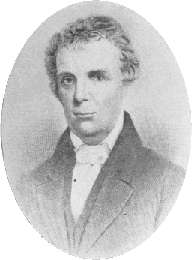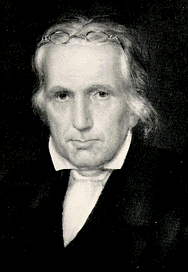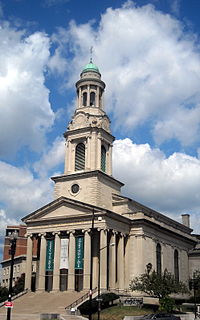
The Christian Church is a mainline Protestant Christian denomination in the United States and Canada. The denomination started with the Restoration Movement during the Second Great Awakening, first existing during the 19th century as a loose association of churches working towards Christian unity, then slowly forming quasi-denominational structures through missionary societies, regional associations, and an international convention. In 1968, the Disciples of Christ officially adopted a denominational structure at which time a group of churches left to remain nondenominational.

The Restoration Movement is a Christian movement that began on the United States frontier during the Second Great Awakening (1790–1840) of the early 19th century. The pioneers of this movement were seeking to reform the church from within and sought "the unification of all Christians in a single body patterned after the church of the New Testament."

Alexander Campbell was a Scots-Irish immigrant who became an ordained minister in the United States and joined his father Thomas Campbell as a leader of a reform effort that is historically known as the Restoration Movement, and by some as the "Stone-Campbell Movement." It resulted in the development of non-denominational Christian churches, which stressed reliance on scripture and few essentials. Campbell was influenced by similar efforts in Scotland, in particular, by James and Robert Haldane, who emphasized their interpretation of Christianity as found in the New Testament. In 1832, the group of reformers led by the Campbells merged with a similar movement that began under the leadership of Barton W. Stone in Kentucky. Their congregations identified as Disciples of Christ or Christian churches.
Nondenominational Christianity consists of churches which typically distance themselves from the confessionalism or creedalism of other Christian communities by not formally aligning with a specific Christian denomination. Many non-denominational churches have a congregationalist polity, which is self-governing without a higher church authority.
The Churches of Christ are autonomous Christian congregations associated with one another through distinct beliefs and practices based on their interpretation of the Bible. Represented in the United States and one of several branches across the world, they believe in using only Bible texts for their doctrine and practices, citing examples from the early Christian church as described in the New Testament. Most typically, their distinguishing beliefs are that of adult baptismal regeneration and the prohibition of instruments in worship. They identify themselves as being nondenominational.

The International Churches of Christ (ICOC) is a body of co-operating, religiously conservative and racially integrated Christian congregations. Beginning with 30 members, they grew to 37,000 members within the first 12 years. Currently they are numbered at over 131,000. A formal break was made from the Churches of Christ in 1993 with the organization of the International Churches of Christ. The ICOC believes that the whole Bible is the inspired Word of God.
The group of Christians known as the Christian Churches or Churches of Christ are congregations within the Restoration Movement that have no formal denominational affiliation with other congregations, but still share many characteristics of belief and worship. Churches in this tradition are strongly congregationalist and have no formal denominational ties, and thus there is no proper name that is agreed to apply to the movement as a whole. Most congregations in this tradition include the words "Christian Church" or "Church of Christ" in their congregational name. Due to the lack of formal organization between congregations, there is a lack of official statistical data, but the 2016 Directory of the Ministry documents some 5000 congregations in the USA and Canada; some estimate the number to be over 6,000 since this directory is unofficial.
The Churches of Christ in Australia is a Christian denomination with British and American origins. It is part of the Restoration Movement and has historically been concerned with the restoration of New Testament patterns of Christianity as a means of encouraging unity among Christians.

Barton Warren Stone was an American evangelist during the early 19th-century Second Great Awakening in the United States. First ordained a Presbyterian minister, he and four other ministers of the Washington Presbytery resigned after arguments about doctrine and enforcement of policy by the Kentucky Synod. This was in 1803, after Stone had helped lead the mammoth Cane Ridge Revival, a several-day communion season attended by nearly 20,000 persons.
Thomas Wayne "Kip" McKean II is an American former minister of the International Churches of Christ and is a current minister of the City of Angels International Christian Church and World Missions Evangelist of the International Christian Churches, also known as the "Portland/Sold-Out Discipling Movement".

Thomas Campbell was a Presbyterian minister who became prominent during the Second Great Awakening of the United States. Born in County Down, he began a religious reform movement on the American frontier. He was joined in the work by his son, Alexander. Their movement, known as the "Disciples of Christ", merged in 1832 with the similar movement led by Barton W. Stone to form what is now described as the American Restoration Movement.

The Evangelical Christian Church(Christian Disciples) as an evangelical Protestant Canadian church body in North America (2004) can be traced to the formal organization of the Christian Church in 1804, in Bourbon County, Kentucky under the leadership of Barton Warren Stone (1772–1844). The Stone Movement later merged with the efforts of Thomas Campbell (1772–1854) and his son Alexander Campbell (1788–1866) to become the Restoration Movement that gave birth to the Churches of Christ (Non-Instrumental), the Christian churches and churches of Christ, the Churches of Christ (non-institutional), and the Disciples of Christ. The Evangelical Christian Church as a separate group within the Restoration tradition was reorganized in 2001. The Evangelical Christian Church's national office in Canada is in Waterloo, Ontario.

National City Christian Church, located on Thomas Circle in Washington, D.C., is the national church of the Christian Church. The denomination grew out of the Stone-Campbell Movement founded by Thomas Campbell and Alexander Campbell of Pennsylvania and West Virginia and Barton W. Stone of Kentucky.
The Brush Run Church was one of the earliest congregations associated with the Restoration Movement that arose during the Second Great Awakening of the early 19th century. In 1811, a congregation of Christian reformers known as the Christian Association of Washington (Pennsylvania) reconstituted itself as a church and constructed a new building to replace the temporary log building where they began. Because it was built on the farm of William Gilchrist, near a stream called Brush Run, both the building and the congregation became known as Brush Run Church. It was the center of activity for Thomas and Alexander Campbell, father and son respectively, in their movement for Christian reform on the American frontier. The meeting house was later used as a blacksmith shop, then as a post office and finally it was moved to Bethany, Virginia.

The United Church of Christ in the Philippines is a Christian denomination in the Philippines. Established in its present form in Malate, Manila, it resulted from the merger of the Evangelical Church of the Philippines, the Philippine Methodist Church, the Disciples of Christ, the United Evangelical Church and several independent congregations.
The Christian Messenger was a religious magazine established by the early Restoration Movement leader Barton W. Stone in 1826. The paper was a key means of communication for the "Christians" led by Stone and a primary source of unity in the movement, but consistently struggled for survival. It also played a key role in promoting the merger of the "Christians" with the "Disciples" led by Thomas and Alexander Campbell.
The American Christian Missionary Society (ACMS) was the first missionary organization associated with the Restoration Movement.

Sharon E. Watkins is an ordained Christian minister who became the first woman to lead a mainline denomination in North America in 2005, when she was elected the General Minister and President of the Christian Church in the United States and Canada. She served two six year terms. She preached at the national prayer service on January 21, 2009, at the invitation of President Barack Obama, becoming the first woman to preach at an inaugural prayer service. In 2017, after stepping down from the role of General Minister and President of the Christian Church, she became director of the Truth and Racial Justice Initiative of the National Council of Churches of Christ, USA. She is currently the pastor of Bethany Memorial Church, in Bethany, West Virginia.

Jessie Trout was a Canadian missionary to Japan for nearly 20 years until she left Japan during World War II. She was a leader in the Disciples of Christ and the first woman to serve as vice president of the United Christian Missionary Society. She was a member of the Disciples of Christ, an author, translator, and co-founder of the Christian Women's Fellowship (1950) and the International Christian Women's Fellowship (1953).
Central Christian Church, also known in its early years as the Church of Christ in Indianapolis and Christian Chapel, is located at 701 North Delaware Street in downtown Indianapolis, Indiana. Its members formally organized on June 12, 1833, as the city's first Christian Church congregation. The congregation formally adopted the name of Central Christian Church on February 3, 1879. Its red brick and stone masonry Romanesque Revival-style church was dedicated in 1893. Building additions were completed in 1913 and in 1922. The church continues to serve the Indianapolis community and holds weekly worship services.